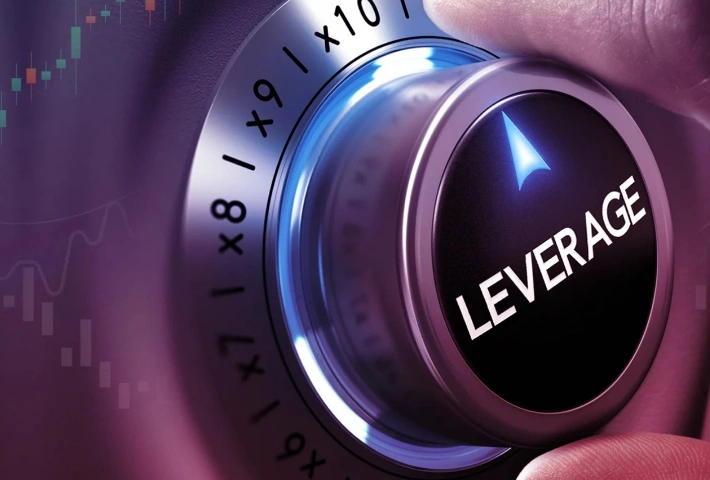Leverage in forex is a technique that enables traders to ‘borrow’ capital in order to gain a larger exposure to the forex market, with a comparatively small deposit. It offers the potential for traders to magnify potential profits, as well as losses.The forex market offers some of the lowest margin rates (and therefore highest leverage ratios) compared to other leveraged assets, making it an attractive proposition for forex traders who like to trade using leverage. Forex is traded on margin, with margin rates as low as 3.3%. A margin rate of 3.3% can also be referred to as a leverage ratio of 30:1. This means you can open a position worth up to 30 times more than the deposit required to open the trade.
In Forex trading, leverage allows traders to control a larger position in the market with a smaller amount of their own money. Essentially, it’s like borrowing money from your broker to increase your potential profit (or loss). Leverage is a double-edged sword—while it can enhance profits, it also increases risk. Always manage your risk wisely.
Here’s how it works:
- Suppose you have $1,000 in your account and you use leverage of 100:1. This means that for every $1 of your own money, you can trade $100 in the market. So, with $1,000, you can control a position worth $100,000.
- Leverage Ratio: A common leverage ratio in Forex is 50:1, 100:1, or even 500:1, depending on your broker and your country’s regulations.
- Amplified Gains and Losses: Leverage amplifies both potential profits and potential losses. If the market moves in your favor, you could make a large profit. If the market moves against you, your losses could exceed your initial deposit.
- Margin: The amount of money required to open a leveraged position is called the margin. For example, if you’re using 100:1 leverage, you only need 1% of the total trade size to open a position. Margin requirements can differ between brokers, but start at around 3.3% for the most traded currency pairs, such as EUR/USD, USD/JPY and GBP/USD.
As we can see from the table above, the lower the margin requirement, the greater amount of leverage can be used on each trade. However, a broker may require higher margin requirements, depending on the particular currency being traded. For example, the exchange rate for the British pound versus Japanese yen can be quite volatile, meaning it can fluctuate wildly leading to large swings in the rate. A broker may want more money held as collateral (i.e. 5%) for more volatile currencies and during volatile trading periods.
Impact of leverage:
To calculate the impact of leverage on your trades in real-time, you need to focus on a few essential components: the position size, the margin required, the pip value, and the potential profit or loss based on price movement.
Let’s break down the process step by step:
- Understand the Basic Formula for Leverage Impact
The impact of leverage can be calculated using this simple formula:
Leverage Impact=Position Size×Price Movement
Where:
- Position Size: The total size of your trade, which includes the amount borrowed due to leverage.
- Price Movement: The number of pips the price has moved.
- Step-by-Step Example
Let’s work with an example to understand how the calculations play out.
Scenario:
- You have $1,000 in your account.
- You use 100:1 leverage.
- You open a position on the EUR/USD pair (1 standard lot = 100,000 units of the base currency).
- The exchange rate for EUR/USD is 1.2000 (this means 1 euro = 1.20 USD).
- The market moves 50 pips in your favor (1 pip = 0.0001 for most Forex pairs).
Step 1: Calculate Position Size
With 100:1 leverage, your position size is 100 times the money you invest. If you invest $1,000 of your own money with 100:1 leverage, you can control a position worth $100,000.
Position Size=$1,000×100=$100,000
Step 2: Determine the Pip Value
The pip value depends on the currency pair and the size of your position. For most Forex pairs, 1 pip equals 0.0001 in price change, but the pip value changes with position size.
For EUR/USD:
- If you trade 1 standard lot (100,000 units), the pip value is $10 per pip.
Step 3: Calculate Profit/Loss Based on Price Movement
Now, let’s say the price moves 50 pips in your favor. With a position size of 1 standard lot (100,000 units), and a pip value of $10:
Profit or Loss=Pip Value×Number of Pips Moved
Profit=50 pips×10 $ per pip=$500
So, with 100:1 leverage and a 50-pip move in your favor, you would make $500, which is 50% of your original $1,000 investment.
Step 4: Calculate the Impact of a Negative Price Movement
If the market had moved 50 pips against you, the loss would be the same, but in the opposite direction:
Loss=50 pips×10 $ per pip= −$500
This loss would represent 50% of your $1,000 account, and another similar move would potentially wipe out your entire account.
- Real-Time Impact Monitoring
To calculate the impact of leverage in real time, you’ll need to monitor the following:
- Current Position Size: Depending on your leverage and margin, this can be significantly larger than your initial investment.
- Live Pip Value: The pip value changes with the currency pair you are trading and the position size. For most major pairs like EUR/USD, 1 pip for a standard lot is approximately $10.
- Price Movement in Pips: This is how many pips the market has moved since you opened the trade. Most trading platforms display real-time pip movement.
- Using a Trading Platform to Calculate Leverage Impact
Most trading platforms, like MetaTrader 4 (MT4) or MetaTrader 5 (MT5), calculate this in real-time for you. Here’s how you can track leverage impact using these platforms:
- Enter Trade Details: Input your leverage ratio and trade size when opening a position.
- Monitor Pip Movement: The platform will show the real-time price movement in pips and the current profit/loss based on your leveraged position.
- Check Margin Usage: Most platforms will also show your margin usage and remaining free margin, so you know how much of your account is at risk.
- Formula for Leverage-Based Position Size and Margin Requirement
To understand how much leverage you’re using and the margin required, you can use these formulas:
- Position Size Calculation:
Position Size=Account Balance×Leverage Ratio
For example, with $1,000 and 100:1 leverage:
Position Size=1,000×100=100,000
- Margin Requirement:
The margin is the amount of capital you need to open a trade with leverage. It is based on the leverage ratio and the size of your position:
Margin Requirement=Position Size/Leverage Ratio
For a $100,000 position with 100:1 leverage:
Margin Requirement=100,000/100=1,000
This tells you that you need $1,000 to open a $100,000 position with 100:1 leverage.
Key points:
- Leverage amplifies both profits and losses, so you must carefully calculate the potential impact on your trades.
- Use formulas to calculate position size, pip value, and the impact of price movements.
- Trading platforms help with real-time tracking of your leveraged positions, margin usage, and profits/losses.
- Always apply risk management techniques like stop-loss orders and limiting your leverage to protect your account from excessive risk.


